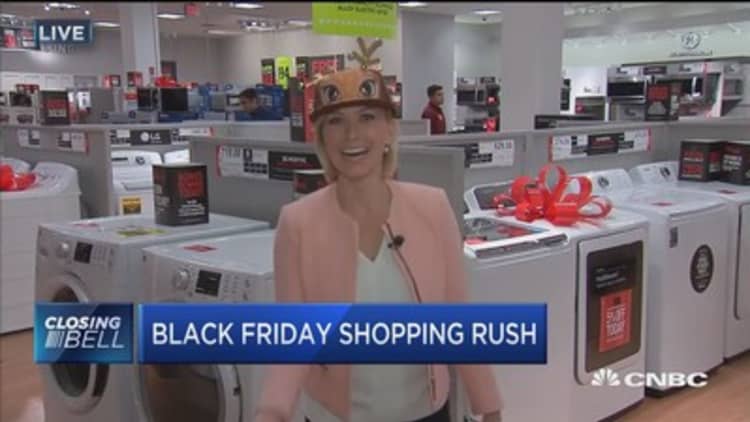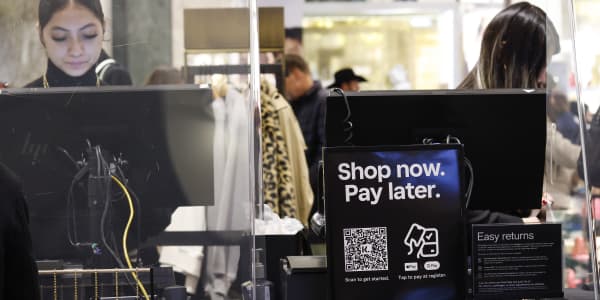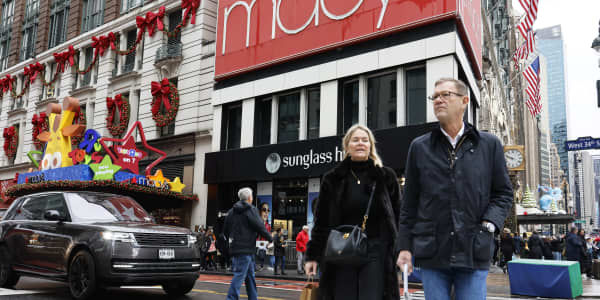From magic mirrors to selfie walls, retailers' haphazard attempts to court millennial shoppers have not been short on gimmicks.
Perhaps that's what makes J.C. Penney's approach refreshingly simple.
Instead of throwing the latest trends and technologies in the face of these shoppers, Penney's has honed in on one specific subset of the diverse generation: millennial moms. This group numbers more than 14 million in the U.S., according to Pew Research.
Penney's says its "emerging customer" base, which includes these women, accounts for 45 percent of its revenue. Millennial moms are also driving much of the growth in the company's sales and customer count.
Now, as the department store chain tweaks its product assortment and sharpens its focus on this shopper, it sees more opportunity ahead.
"We want to be able to deliver her needs both as a woman and as a mother," Sheeba Philip, J.C. Penney's vice president of marketing strategy and communications, told CNBC. "That's a huge unmet need."
What's at the top of her shopping list
While Kantar Retail data show that the average age of J.C. Penney shoppers is climbing closer to 51, the department store chain started to notice that many of its newest customers were young women between 30 and 40. Not only that, but these shoppers were visiting the retailer more frequently, and spending more than the average customer.
Penney's courtship of millennial women has multiple prongs. But the center of its thesis remains consistent, Philip said: thinking of her first as a mom. To better meet the specific needs that come with that role, Penney's this holiday has brought a dedicated toy section back to its kids' department — a specialty seasonal carve out that was scrapped under Ron Johnson's leadership.
Featuring well-known brands like "Paw Patrol" and "Teenage Mutant Ninja Turtles," toys drove strong traffic on JCPenney.com on Cyber Monday, and quickly became one of the most frequently searched terms on its site, the company said.
Along with its push into children's categories, Penney's is leaning into its new fast-fashion line, Belle & Sky, to cater to millennial moms' style. It's also getting traction from these shoppers in its Sephora shop-in-shops and InStyle-branded beauty salons. Sephora has consistently been one of Penney's top-performing categories, and it will add at least another 60 locations in 2017.
"Sephora has allowed us to expand our product offering by introducing new compelling industry-leading prestige brands into our assortment," CEO Marvin Ellison told analysts last month.
Looking ahead, Penney's sees a "huge opportunity" to build upon its home business, and make its stores a destination in the category for millennials, Philip said. To some degree, that includes its return to appliances earlier this year.
The company is meanwhile testing tweaks to its floor plan in certain millennial-heavy markets, which include switching out its more traditional Worthington brand at the front of the store for its Belle & Sky label.
Penney's declined to share what markets those tests are operating in, but said it will have more details to share next year.
Penney's natural advantage
In several ways, the makeup of the millennial shopper base is on Penney's side. That's because it has historically been successful in its efforts to woo immigrant, Hispanic and multicultural shoppers, Craig Johnson, president of Customer Growth Partners, told CNBC.
Part of that strength is due to the company's store base. Though Penney's "bread-and-butter" is in the so-called flyover states, Johnson said, it operates 80 locations in California, 92 in its home state of Texas and 55 in Florida, according to its website. That means those three states make up nearly a quarter of the company's store base.
"More than ever, the millennial shopper is a multicultural shopper and vice versa," Jordan Rost, vice president of consumer insights at Nielsen, told CNBC.
Another reason Penney's has done well with this group of shoppers is its prices. Because many millennials came of age during the financial crisis, and have struggled to grow their wages, value is extremely important to them, Johnson said.
Indeed, data from Kantar Retail show that the average J.C. Penney shopper earns $62,850 a year. That compares with $69,605 for Kohl's customers, and $75,059 for Macy's.

Yet the company still lags Macy's and Nordstrom when it comes to grabbing millennials' dollars, Kantar's research shows. As it looks to grow its base, the biggest challenge it faces is its fashion department, Johnson said.
"They're on trend but they aren't exactly leading trend," Johnson said, referring to many millennials' preference to shop at fast-fashion chains like Zara.
Penney's millennial push is just one piece of the chain's turnaround strategy. Under Ellison's leadership, the retailer's sales trends have been faring better than the other major department stores, though they are coming off a smaller base.
During the third quarter, Penney's comparable-store sales recorded an unexpected decline, the result of sluggish apparel sales. In the holiday quarter, the company is facing a tough comparison from last year, when comparable sales rose 4.1 percent. Despite these challenges, analysts say Penney's initiatives and rational inventory levels should give it the opportunity to grow both sales and gross margin.
"I think for holiday they're well-positioned," Johnson said.
(CORRECTION: Emerging customers, which include millennial moms, account for 45 percent of J.C. Penney revenue. A previous version of the story attributed all of this revenue to millennial moms.)





